danbricklin.com/log
|
||
|
|
Starting October 15, 2004
Another shared experience on the plane, Tied into pop culture on JetBlue, Fiber to my home, Weinberger at Berkman and blogging compared to cassette tapes, This blog is five years old, Computer History Museum Fellow Awards ceremony, Future Forward conference
15Oct04-14Nov04
2004_10_15.htm
|
|
|
Another shared experience on the plane [link]
This morning on the 7 a.m. return flight to Boston I had another shared experience with others on the plane. As I was getting comfortable in my seat, taking out some reading material before taking off, someone a row on two behind, still in the aisle, yelled out something like "Way to go, Johnny!" A few others made some approving sounds. I assumed it was a group and Johnny had made it on when they didn't expect him to. More cheer from a good time at Disney World or something. Then some others clapped. I looked forward to see who was getting on. Lo, and behold, it was Johnny Damon, center fielder of the (I love to say this) World Series Champion Red Sox. What a treat! (The gift for the friends I had just visited were Red Sox hats bought in the Boston airport on the way down on Friday.) After several seconds of applause, people quieted down, and left him alone for the flight (well, every time he stood up flashes went off, and one person handed his cell phone to the stewardess to take a picture of Johnny a few rows ahead, but people didn't walk up asking for autographs or anything). When we landed, he pulled down his carry on and left to take a cab. As I got off the plane, I passed by all these people who were waiting to get on the plane for their flight who were now on their cell phones: "You wouldn't believe...", "No, I couldn't get a picture with my cell phone, but I tried..." (We couldn't do this when we first saw him -- who are you going to call at 6:50 in the morning for something like that? I sent an email from my Treo, though, and then am blogging now that I'm home...) The urge to share an experience is great.
I talked to another passenger at the baggage claim who told me that he had noticed this person who looked a lot like Johnny Damon in the security line. Remembering an article he had recently read in the Orlando paper he knew that Johnny had been in town to receive some award (here's something on the web about it). So as the security line snaked back on itself and he passed by, he said "Hi, Johnny!" He said that Johnny looked surprised that someone recognized him (obviously dozens who had seen him had not and many of us were going to Boston and would surely know who he is and what he looks like), and they talked a bit. I know that if I hadn't heard that person cry out at the back of the plane, I wouldn't have known he was on board, even though he looks just like he does on TV and I've watched his face intently many times when he was at bat. I wonder how many other people whose stories I know I pass by every day that I don't know about. The world is more connected than you think, and we know more as a group than we do as individuals. Here are some pictures:
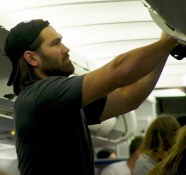 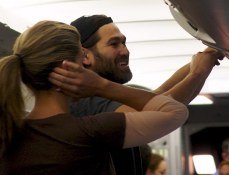 Johnny Damon of the Red Sox seen on the plane
Tied into pop culture on JetBlue [link]
I had a strange experience just now. I'm flying JetBlue for the first time. They have personal flat-panel displays at each seat, with satellite feeds. 36 channels (well, not all were working). When I flew a few weeks ago on United during an historic Red Sox game, we were lucky to hear updates every half inning from the pilot (I made it home in time to watch the end). I was putting the final touches on a keynote speech I'm giving next week at the Computer Reseller News Hall of Fame Awards. One of the points I make is about mobility, connectivity, and the move from point products to modular systems. Then I started listening to Adam Curry's November 11th podcast. This was the first one of his that I'd listened to (I tend more to the ITConversations type of podcasts so far). Adam is more tilted to pop culture than Doc Searls and the Gillmor gang, with his music and his background and stuff. Then I got a real dose of pop culture: Up on the screen of the person next to me was Court TV: The Scott Peterson trial verdict was going to be announced in a few minutes. They were going to have a live audio feed. I haven't followed this trial at all, so I wasn't too interested, but from the number of times I've heard reference to it in the news, I guess it's a big deal to lots of people. Looking down the aisle, as the time grew closer more and more screens were showing Court TV. Finally the verdict: Guilty. (Even I paused Adam, and moved my earphones from MP3 player to seat phone jack so I could take a picture at the correct moment.) A few minutes later, most people were back to watching the other stuff. Court TV was still talking about the trial -- hours and hours on the same thing during this flight. I listened to some classical music on my MP3 player and blogged.
 Watching TV
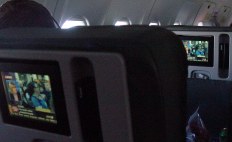 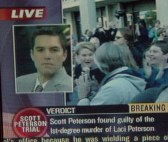 The Peterson verdict
Fiber to my home [link]
A few weeks ago Verizon announced that they were rolling out fiber to the premises in parts of more states, including Essex and Middlesex counties in Massachusetts. I live in Middlesex, and when I stepped out on the porch to take in the mail this afternoon what should I see but a truck slowly putting up new fiber -- fiber to my home. Their FiOS service gives you up to 30Mb down/5Mb up already. (The requirements say 100BaseT, not 10BaseT, for your network card! It's $199.95/mo., 5 times the $39.95 price for 5Mb/2Mb.) Cool! I guess I'll soon be ditching the DSL I use as backup to my cable modem.
Here are some pictures:
 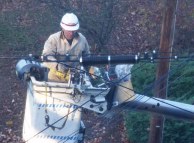 The truck on the street, the view out my office window as the fiber cable is being added to the bundle of cables outside
Weinberger at Berkman and blogging compared to cassette tapes [link]
I went to Dave Weinberger's open discussion last night at the Berkman Center. The topic was called "The Net and Democracy". Coming off of the election, discussion moved to what to do next, especially among those that felt that the Net hadn't contributed enough to make Democracy work out the way they would have liked. For me, more importantly, it was a time to see some friends who attended and meet some new people as well as think some big thoughts.
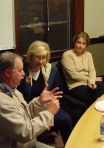 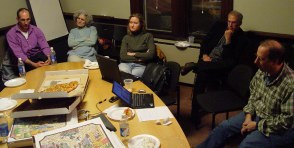 Some of the people last night, David Weinberger on the far right :)
I wanted to talk at a high level (after all, we were on the grounds of Harvard Law School, just down the block from Harvard Divinity School), such as about rethinking how a society's decision making is structured for its benefit when you have the Net, or how the election exit poll results relate to the role of spiritual aspects of life (not just the specific issues, but that they came from the spiritual side of people) as opposed to their pocketbook or physical security side. (I've written about the importance of people's emotional side many times, including the popular "What will people pay for?' essay.) But many wanted to talk about tweaks to blogging tools and such. The energy from the election made some of us very action oriented.
I pointed out that in the last day or so, the word "blog" was sometimes as common as "newspaper" or "telephone" (and more than "mailed literature") when we listened to major participants in the election on TV. Who would have thought that such a young technology would rise so fast to such prominence? It took 20 years for the computer mouse to become well known enough to be part of a joke in a movie (Star Trek IV), and over 10 years more to be on most desks. I also reminded people that technology can be used by everyone. Don't assume that it selects for one party or another.
This morning while jogging and listening to the podcast "The Future of Online Content" that I picked up on ITConversations, I got another thought. We had mentioned podcasting as a potential technology to be used politically. Just as blogging has an analog in the old activity of pamphleteering (as I pointed out in "Pamphleteers and Web Sites"), listening to recorded talks by noted individuals and passing them around has been used for years with audio cassette tapes and is still used. I remembered how we keep hearing of discoveries of cassette tapes of speeches when terrorist hideaways are raided. Look at this discussion of the styles of presenting material on cassettes I found: "Islamist Cassettes & Tradition in Yemen". It tells of messages on the covers of cassettes such as "In the summons to God's righteous path, the Islamic cassette is a superb means", or "May God grant blessings on whomever helps disseminate this cassette." Podcasting is not as related to music and the RIAA as it is to religious and other leaders and books on tape. The value podcasting brings is in the ease of reproduction (just bits), distribution (server or email or CD or flash disk), and recommendation (a link or term to Google). The emotional love of music is getting people to buy MP3 players, and there's lots of extra room on them for podcasts. Many people's lives have time slots in them that lend themselves to listening, even if only in 10 or 20 minute chunks (unlike radio, podcasts can be paused or repeated). Just wait and see what happens when sending 60 minutes of audio (about 20MB or so) is considered as low-resource as forwarding a joke or photo is today. Like most technology, it can be used by all parties, for good or bad. Like pamphleteering in Revolutionary times, or cassette tapes in the last decade, you ignore this technology at your peril.
This blog is five years old [link]
A day after Dan Gillmor celebrated his blog's fifth anniversary, I celebrate the same one over here. My first day had several posts. Blogging was a step up in frequency from the periodic essays and topic-oriented websites I had created in the year and a half before that. Over the years posting frequency has dropped from every day or so to every week or so, but it hasn't stopped. I really love the connection to the world you get from blogging and my readers keep encouraging me and teaching me. It has become part of who I am. Thanks to all you readers and especially to those who've sent comments in over the years or gave them to me in person.
Computer History Museum Fellow Awards ceremony [link]
Last night was the Computer History Museum's Fellow Awards dinner and ceremony at their building in Mountain View, CA. The previous 27 Fellows include Grace Murray Hopper (the first recipient), Jay Forrester, Ken Olsen, Mitch Kapor, Woz, Thompson and Ritchie, Knuth, Vint Cerf, Berners-Lee, and Gordon Bell. A great group. Bob Frankston and I were among the Award Recipients in 2004 "for advancing the utility of personal computers by developing the VisiCalc electronic spreadsheet." What an honor! The other recipients this year were: Niklaus Wirth "for seminal work in programming languages and algorithms, including Euler, Algol-W, Pascal, Modula, and Oberon", Erich Bloch "for engineering management of the IBM Stretch supercomputer, and of the Solid Logic Technology used in the IBM System/360, which revolutionized the computer industry", and Bob Evans "for excellence in the management of computer systems, hardware, and software development projects, including the IBM System/360, which revolutionized the computer industry." Here are some pictures:
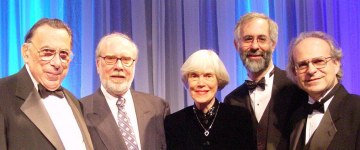 Erich Bloch, Niklaus Wirth, Maria Evans (wife of the late Bob Evans), Dan Bricklin, and Bob Frankston
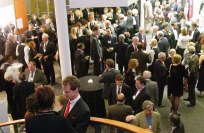 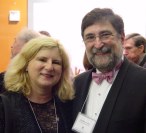 The crowd during the reception before, Nancy Engel and Sheldon Laube
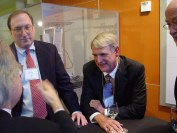  Bob Frankston talking to John Shoch, Dave House, and Gardner Hendrie, Donna Dubinsky
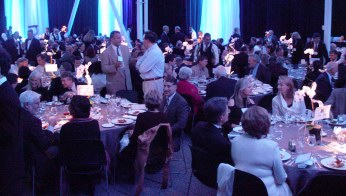 Right before dinner
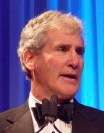 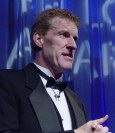 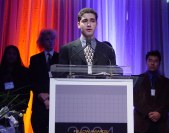 Master of Ceremonies Bill Campbell, comedian Don McMillan, young people from the Digital Clubhouse Network
The entertainment for the evening was comedian Don McMillan. While Don was a $100,000 Grand Champion on "Star Search" in 1993 and has been on the "Tonight Show", he's more than a normal comedian. He has a Masters in Electrical Engineering from Stanford and spent years designing computer chips at VLSI Technology. He was quite funny, and most happily, funny when touching on engineering. Most comedians seem to have a real problem writing "engineering literate" jokes without obvious "bugs" (they speak with a liberal arts accent, not a techie one). Some I remember from last night: What is PI? Mathematician: Ratio of circumference to diameter. Physicist: 3.141... (never stopping). Engineer: 3 should be good enough, but we could use 4 to be sure. Example of marketing using statistics to say anything: Your chances of getting Alzheimer's by age 85 are 1 in 10. The average smoker lives to age 66. Marketing: Smoking lowers the chance of getting Alzheimer's. He had some good Powerpoint jokes, too.
The young people from the Digital Clubhouse Network told how they had interviewed Niklaus Wirth and were producing a digital story out of it. The speaker sounded so driven to take down firsthand history from computer pioneers. It was moving to hear how the next generation has people who care about preserving the history of computing. After attending events like this and board meetings mainly attended by people my age and older who were part of it all, this was a glimpse into the future to see how the story of the birth and growth of something so important will be treasured and preserved.
Of course through all this lots of us were hitting "refresh" repeatedly on PDA browsers to see how the Red Sox were doing. Quite an exciting night. (And an opportunity to wear my tux.)
Future Forward conference [link]
Yesterday I attended some of the first day of the Future Forward 2004 conference. It's billed as "The New England Technology Summit" and was held in Portsmouth, NH. I was there as a speaker in the "Demo Session: Bringing Inventions Into the World" session.
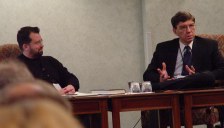 Joost Bonsen of MIT moderates as Clayton Christensen speaks
The first speaker I heard was Clayton Christensen speaking about "Change". He covered a lot of what is in his book, The Innovator's Solution, including material I've blogged from a previous talk, especially the examples about saving money in healthcare by moving things from doctors to nurses to patients. His work is aimed at finding theories for understanding a predicting. He feels that rather than having experts who use experience and intuition to make decisions using seemingly random inputs we need theories to help us instead, with statements of cause and effect. In the long Q&A part, I asked how his theories help in figuring out how to construct long-lasting systems (my "200 Year Software" area). He hadn't thought about it. However, listening to his answer to a previous question, I think that his discussions about modularity might be helpful. (I'll look into that in my next essay in the series.) His last statement: Data is only available about the past, you need theory to deal with the future. Sometimes by the time many bad trends show up in the data the game is already over. As usual, he's a great speaker on an important topic.
Future Forward, like it's sister conference, the Nantucket Conference on Entrepreneurship & Innovation, has a very high level audience with a sense of community and closeness to the speakers that leads to great questions from the audience.
 Peter Burrows of Reebok, Jo Hoppe of Pegasystems, David Fialkow of General Catalyst, John Landry of Adesso Systems, Dan Keshian of iPhrase, and George McQuilken of eCoast Angels Network
The next session was a panel on IT money and funding led by John Landry. It included Peter Burrows, CIO of Reebok, telling us how they will buy products from small companies if it addresses a pain point. They just need to have that issue in the budget and they will substitute buying one product for a different one if you convince them yours is much better. Clear pain points mentioned on the panel were dealing with auditing, especially Sarbanes-Oxley stuff and disaster recovery. When you do get through to someone like him, you had better have a real clear, short story with obvious, measurable ROI. That short elevator pitch is crucial.
Jo Hoppe, CIO of Pegasystems, gave an example: Once you get hit by a DOS or spam attack, out comes the checkbooks. Her advice on another topic: If you don't have reference accounts, make sure you use your own stuff internally.
The session I was on was moderated by Evan Schwartz, who has covered the high tech industry for many years at various publications and is the author of the new book "Juice: The Creative Fuel that Drives Today's World-Class Inventors". The other three panelists were there to demo products. I was there to be included in the discussion of how invention happens based on our experience and to comment on what I heard from the others.
James McLurkin, senior lead research scientist at iRobot and currently at MIT's Computer Science and AI Lab, showed us some of his prototype swarming robots. He has always wanted to make better toys and has a fascination with swarms like ants (which he keeps as pets). His little robots roll around on the floor, organize themselves (with programs that don't know how many of them there are, communicating with wireless, IR, touch, vision, and more), march in lines playing tunes, fill up spaces, find their power supply, and more. The power finding and self-plugging in is important. While he showed us just 15 of them, he has over a hundred in his lab, and hand recharging them all would be a pain. He showed us how his initial sophisticated design for the charging docking connectors was simplified into two brass posts and told us how using a mold for both sides of the units made it easy to have two speakers (with 1 watt total of power) for sound. He had a slide: "The Magic of Complexity: Simple local interactions that form complex group behaviors. This is how insect communities work (and schools of fish, weather, traffic jams, etc...) Is this how our brains work?" He told how he looks to the biological world for inspiration, not to do imitation. His stuff is really cool.
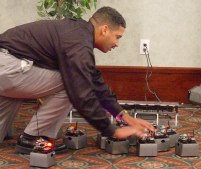 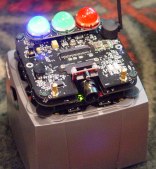 Starting them up by pressing reset near the charging dock, a close-up
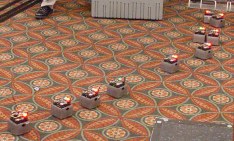 Organizing into a line playing the music to "Hi ho, Hi ho, It's off to work we go..."
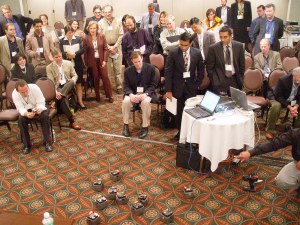 Us watching
Isaac Berzin of GreenFuel Technologies Corporation, an MIT spin off, is driven to change the world for the better. He's chosen to do that through making energy cleaner and cheaper. He's figured out a way to make efficient use of sunlight and algae to remove NOx and CO2 from fossil fuel burning systems and at the same time grow that algae to be used as biomass for energy production. A large prototype is currently being used at MIT's 20MW cogeneration plant and is exceeding expectations. He showed us a small model to explain how it works, keeping the algae moving to give it even exposure to light and keep the parts clean.
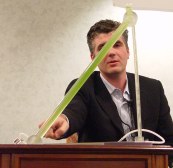 Isaac showing us the model
Finally, Mark Sorensen, SVP Information Management Software at EMC Corporation, showed us a prototype of a system they were working on to monitor phone calls and other communications that use corporate policies to decide which should be recorded, tagging them with metadata, and taking actions if necessary. He demoed making a live telephone call and how saying the word "explosion" triggered actions in realtime.
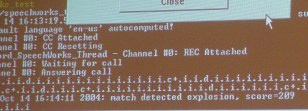 Realtime output as a phone conversation progressed
There is much more at the conference, but that's all I was able to cover.
|
||
|
© Copyright 1999-2018 by Daniel Bricklin
All Rights Reserved.
See disclaimer on home page.
|
||